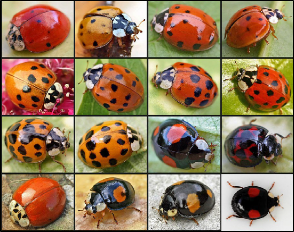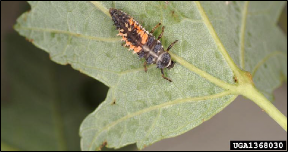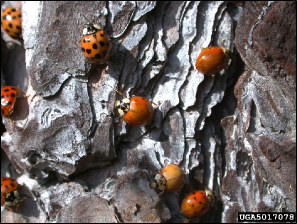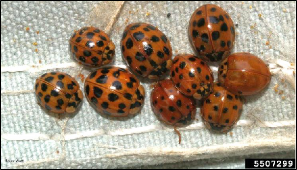Ladybird Beetles in Houses and Buildings
ID
ENTO-472NP
Introduction
Harmonia axyridis is a nonnative ladybird beetle with many different common names, including multicolored Asian lady beetle (sometimes abbreviated as MALB), harlequin ladybird, Halloween beetle, and Asian ladybird beetle. Even the name “ladybird beetle” can be confusing as it’s often interchangeable with “ladybug” or just “lady bird.” Some people insist that these beetles are not “true” ladybugs, but they do belong to the family Coccinellidae in the order Coleoptera, along with all the other beetles called lady beetles, ladybugs, and ladybird beetles.
Identification
Adult MALB are small insects with highly domed bodies that are flattened underneath. The bodies are very shiny, but highly variable in their coloration and markings (Fig 1). The beetles can range in color from tan, orange, reddish-orange, red, or black. The markings on the wing covers can vary from no black spots to many black spots, or in the case of darker specimens, from localized patches of color to multiple spots of color. The pronotum directly behind the beetle’s head is often light colored with black spots or a black marking in the shape of a M or a W (Fig. 1). However, some beetles have largely dark pronotums with lighter patches on the margins. Such variation makes recognizing MALB difficult for those unfamiliar with this species.
MALB larvae are frequently described as “alligator- like” as they are elongated with spiky bumps on their back (Fig. 2). They also vary in color as they mature, but they are generally blackish-gray with orange markings in the middle of the body.
Distribution
MALB are found throughout the continental United States. They are frequently noted in urban and rural areas, particularly when the adults congregate in the fall.


Life Cycle
Like all beetles, MALB has a life cycle consisting of the egg, larval, pupal, and adult stages. Gardeners may recognize MALB larvae on their plants during the spring and summer, but many homeowners are only familiar with the adult MALB when they begin to congregate on warm sunny days in mid to late October, or when they appear inside houses or buildings. Adult females emerge from overwintering sites in the spring to lay eggs on plants. MALB larvae hatch and feed on soft bodied arthropods like aphids, mites, scales, as well as the eggs and young larvae of larger insects. Mature MALB larvae pupate on foliage, branches, the sides of buildings, and similar sites. Adults emerge and continue feeding on soft bodied insects before mating and laying eggs. There are multiple generations per year in Virginia.
In the fall, when triggered by declining daylight and colder temperatures, adult MALB begin to congregate in sunny sites, including the sides of houses and other buildings, rock walls, tree trunks, and other places that would offer shelter during the winter months (Fig. 3). Large numbers of adults can be observed outdoors on sunny afternoons in October. MALB form clusters and attract more adult beetles to an overwintering site through the release of aggregation pheromones (Fig. 4).

Damage
As larvae, MALB is a beneficial predator of aphids and other plant pests found in forests, gardens, and agricultural crops. The adults also eat insect pests, but they are considered nuisance insects once they congregate on the sides of houses and building, and when they invade these structures through crevices, cracks, gaps, and holes. MALB may cluster in attic spaces, wall voids, behind siding, inside sheds, and similar sites. Those that enter living spaces are attracted to light and may be seen at windows or around light fixtures. They can be found dying on the floor or windowsills as indoor environments are too warm and dry for their survival. Homeowners should remember that MALB do not infest food, clothing, or wood inside homes, nor do they reproduce indoors. Any MALB found indoors in the spring actually entered the building the previous fall and are trying to find a way back outside after overwintering in cooler parts of the house.

MALB can release a defensive yellowish fluid that has an objectionable odor and will stain some surfaces like walls and fabric surfaces. These defensive fluids taste foul, likely deterring pets from eating more than one or two beetles. Some people experience an allergic reaction in the presence of MALB. As predatory beetles, MALB have mouthparts capable of giving a sharp pinch to the skin, but they are not generally considered to be biting pests of humans or pets.
Control
Limiting access indoors before MALB begins to congregate in the fall is the key to managing MALB inside structures. Limit the entry of MALB into homes by sealing all gaps and crevices, especially in attics and upper areas of the house. Install good window and door screens with a tight fit. Fine mesh screening may be used with vents. Holes and gaps in foundations can be sealed with expanding foam or caulking. MALB entering a home through the exterior wall may gain entrance into the interior living spaces through gaps around ceiling lights and exhaust fans, cracks behind baseboards, and poorly- fitting doors to attic spaces. Seal these gaps as much as possible. These preventative measures will also limit entry by cluster flies and brown marmorated stink bugs, which also invade homes in the fall.
Sweep or vacuum beetles off windowsills and floors when found, but empty the vacuum canister so dead insects do not attract carpet beetles. Insecticides applied to wall voids and the attic may kill MALB, but this may lead to increased numbers of carpet beetles unless the dead MALB can be removed promptly.
Several homeowner and professional-use materials are available as perimeter or barrier sprays to prevent MALB from entering houses or buildings. However, these pesticides should be applied in early fall before adult MALBs begin to cluster. Many homeowners forget to treat their home before MALB appears, and then it’s too late to prevent at least some of them from entering the home. See the Virginia Pest Management Guide for Home Grounds and Animals (VCE 456-018) for the current recommendations for perimeter sprays against MALB (“Asian lady beetles”). These perimeter sprays usually have a short residual span because sunlight quickly degrades them.
Virginia Cooperative Extension materials are available for public use, reprint, or citation without further permission, provided the use includes credit to the author and to Virginia Cooperative Extension, Virginia Tech, and Virginia State University.
Virginia Cooperative Extension is a partnership of Virginia Tech, Virginia State University, the U.S. Department of Agriculture (USDA), and local governments, and is an equal opportunity employer. For the full non-discrimination statement, please visit ext.vt.edu/accessibility.
Publication Date
December 21, 2021



